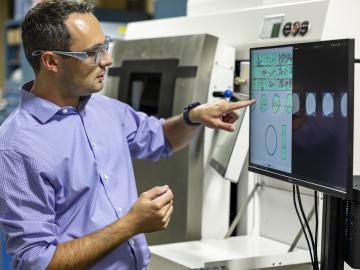Filter News
Area of Research
- Advanced Manufacturing (1)
- Biological Systems (1)
- Biology and Environment (23)
- Building Technologies (1)
- Clean Energy (33)
- Computational Engineering (1)
- Computer Science (1)
- Energy Sciences (1)
- Fusion and Fission (4)
- Isotope Development and Production (1)
- Isotopes (4)
- Materials (41)
- Materials Characterization (2)
- Materials Under Extremes (1)
- National Security (8)
- Neutron Science (16)
- Supercomputing (26)
News Type
Date
News Topics
- 3-D Printing/Advanced Manufacturing (13)
- Advanced Reactors (2)
- Artificial Intelligence (11)
- Big Data (3)
- Bioenergy (13)
- Biology (13)
- Biomedical (2)
- Biotechnology (5)
- Buildings (7)
- Chemical Sciences (12)
- Climate Change (13)
- Composites (3)
- Computer Science (11)
- Coronavirus (3)
- Critical Materials (4)
- Cybersecurity (3)
- Decarbonization (12)
- Education (3)
- Energy Storage (12)
- Environment (13)
- Exascale Computing (3)
- Frontier (4)
- Fusion (2)
- Grid (7)
- High-Performance Computing (13)
- Hydropower (1)
- Irradiation (1)
- Isotopes (2)
- Machine Learning (4)
- Materials (33)
- Materials Science (8)
- Mercury (1)
- Microscopy (4)
- Molten Salt (1)
- Nanotechnology (3)
- National Security (4)
- Net Zero (2)
- Neutron Science (13)
- Nuclear Energy (5)
- Partnerships (18)
- Physics (4)
- Polymers (2)
- Quantum Computing (6)
- Quantum Science (6)
- Renewable Energy (1)
- Security (2)
- Simulation (9)
- Summit (2)
- Sustainable Energy (8)
- Transportation (13)
Media Contacts

The Department of Energy’s Office of Science has allocated supercomputer access to a record-breaking 75 computational science projects for 2024 through its Innovative and Novel Computational Impact on Theory and Experiment, or INCITE, program. DOE is awarding 60% of the available time on the leadership-class supercomputers at DOE’s Argonne and Oak Ridge National Laboratories to accelerate discovery and innovation.

Researchers at ORNL have been leading a project to understand how a high-altitude electromagnetic pulse, or EMP, could threaten power plants.

Scientists at ORNL used their expertise in quantum biology, artificial intelligence and bioengineering to improve how CRISPR Cas9 genome editing tools work on organisms like microbes that can be modified to produce renewable fuels and chemicals.

ORNL researchers determined that a connected and automated vehicle, or CAV, traveling on a multilane highway with integrated traffic light timing control can maximize energy efficiency and achieve up to 27% savings.

Oak Ridge National Laboratory scientists identified a gene “hotspot” in the poplar tree that triggers dramatically increased root growth. The discovery supports development of better bioenergy crops and other plants that can thrive in difficult conditions while storing more carbon belowground.

Researchers at the Department of Energy’s Oak Ridge National Laboratory have improved flaw detection to increase confidence in metal parts that are 3D-printed using laser powder bed fusion.

The application to participate in the third cohort of the Techstars Industries of the Future Accelerator in Knoxville, Tennessee, is open through Nov. 29, 2023.

Currently, the biggest hurdle for electric vehicles, or EVs, is the development of advanced battery technology to extend driving range, safety and reliability.

As vehicles gain technological capabilities, car manufacturers are using an increasing number of computers and sensors to improve situational awareness and enhance the driving experience.

In a finding that helps elucidate how molten salts in advanced nuclear reactors might behave, scientists have shown how electrons interacting with the ions of the molten salt can form three states with different properties. Understanding these states can help predict the impact of radiation on the performance of salt-fueled reactors.




